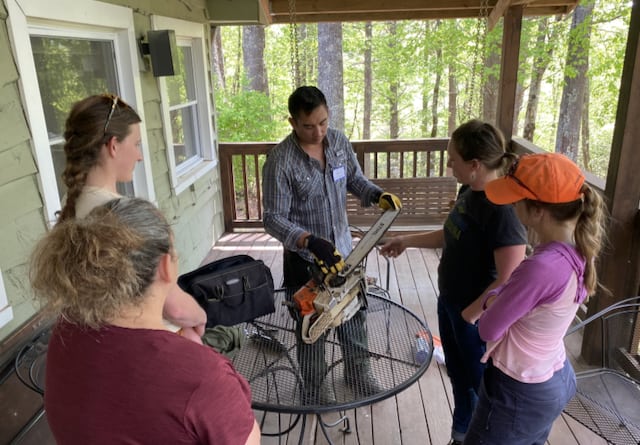Editor’s note: Dakota Wagner is a Southeast Program Manager for the Forest Stewards Guild based in Asheville, North Carolina. Dakota is a member with FAC Net, and her work also overlaps with our partners in the Fire Networks. In her role with the Guild, Dakota is focused on community engagement, forestry education coordination and forest restoration project management. In this blog, Dakota shares details and successes from a recent chainsaw workshop focused on women participants.
Women’s chainsaw workshops are important for promoting gender equality, empowering women, and breaking down traditional gender stereotypes. These workshops provide a safe and inclusive space for women to learn and develop skills in a typically male-dominated field. Landowners and conservation practitioners have the opportunity to meet other women in the field to find community and inspiration. By engaging in chainsaw training, women gain the confidence and knowledge needed to participate in forest stewardship, arboriculture, or…wildfire mitigation!
This May, the Southern Blue Ridge Prescribed Burn Association (SBR PBA) hosted a women’s chainsaw safety and wildfire preparedness training at the North Carolina Forest Service Mountain Training Facility. The SBR PBA is a community-based organization focused on increasing access to prescribed fire on private lands to benefit the Southern Blue Ridge mountains of North Carolina and is currently coordinated by the Blue Ridge RC&D Council.

A participant asks about the inner workings of a chainsaw during the Maintenance and Repair session with Elliot Nauert Photo credit: NCSU Extension Forestry.
The day started with an introduction circle and I gave a brief presentation on wildfire in the mountains. Normally, I would delve into a comprehensive hour-long discussion about the ecology and fire-adapted traits of the landscape – but had to fit the importance of fire in western North Carolina and its connection to chainsaw skills into a mere ten minutes to accommodate all of the day’s activities. I then passed the baton to Joe Mattox from Safe Steps Training, who delivered a thorough lecture on how to safely and effectively use chainsaws. Following a brief lunch break, participants eagerly split into four groups for the highlight of the day: hands-on activities outdoors!
Participants had the chance to cut downed trees to understand the nuances of compression wood and tension wood, hone skills in limbing and pruning, learn about chainsaw maintenance and care, and conduct a Home Hazard Assessment. During the Home Hazard Assessment session, we focused on the places where chainsaw skills could come in handy, such as removing large shrubs (i.e. rhododendron) within the Immediate Zone. Every group rotated through these stations, spending 30 minutes at each one. This immersive experience allowed each participant to wield a chainsaw, observe the intricate inner workings of the tool, and assess potential wildfire hazards at a NCFS cabin.

During the Limbing and Pruning session, participants learned how to safely limb and prune trees and shrubs from Corinna Steinrueck (Warren Wilson College) and Jordi Pfeifer (NC Forest Service). Photo credit: NCSU Extension Forestry.
Incorporating wildfire risk awareness content into a women’s chainsaw workshop was an experiment that I was unsure would play out. I wanted to put audience-based messaging into practice in a very tangible way. Women’s chainsaw workshops are always in high demand, and I knew there would be a captive audience. Overall, the workshop was very well received. Nearly every participant reported learning new skills and gaining confidence in the use of chainsaws. And, it was also successful in spreading the word about wildfire preparedness. In an evaluation survey, participants reported that their understanding of wildfire risk prior to the workshop was between “Low” and “Medium.” After the workshop, it increased to “High.” Additionally, their understanding of Home Hazard Assessments prior to the workshop was “Low” and after the workshop it increased to “High.”

Graphic depicting the increase in participant understanding before and after the chainsaw workshop. Credit: Dakota Wagner, Forest Stewards Guild.
One participant said:
“I enjoyed the camaraderie shared through it being primarily women at this workshop. It was easier for us to connect with one another because some of us had a shared experience of being women who work in the primarily male-dominated industry of land stewardship and maintenance.”

A participant cuts a tree cookie on a downed log with Safe Steps instructor Joe Mattox. Photo credit: NCSU Extension Forestry.
The SBR PBA hopes to host more workshops like this. In fact, the newly formed Piedmont PBA of North Carolina is hoping to use the model and have their own training sometime this fall. If you’re interested in keeping up with the SBR PBA, subscribe to our email list.
A big thank you to NC Forest Service, NCSU Extension Forestry, Warren Wilson College, and WoodenEye Resource Management for helping to organize and conduct the workshop! This program was funded in part by the Renewable Resources Extension Act (RREA) and Fire Adapted Communities Learning Network (FAC Net).
****


Wonderful! Great job Dakota! Looking forward to seeing more of these in the region.